The Stadshuset (City Hall) is the most famous symbol of Stockholm. The iconic landmark, with its signature brick tower, is possibly the most important architectural achievement of the twentieth century in Sweden.

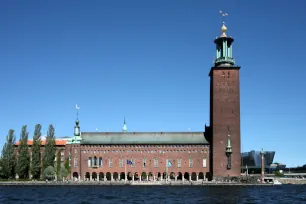
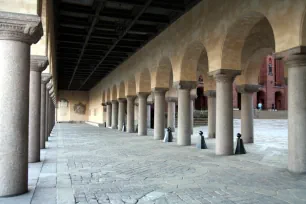
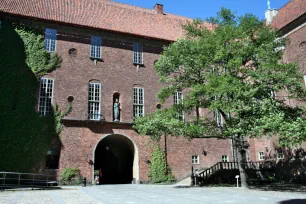
During the Middle Ages, Stockholm’s city hall was located at Stortorget, the main square of the Old Town. In 1732, it moved to the Bonde Palace, at the edge of the Old Town. In the early twentieth century, the need arose for a larger and more modern city hall. A spectacular site at the bank of the Riddarfjärden bay in Kungsholmen was selected as the new location. It was formerly occupied by a steam powered mill that was destroyed by fire in 1878.
The City Hall
The Stadshuset is considered a masterpiece of Swedish National Romanticism, a modern architectural style with domestic roots. The architect, Ragnar Östberg, was also clearly influenced by Italian architecture.
A total of eight million dark red bricks, many handmade, were used for the construction, which started in 1911. The new city hall was – at three times the originally estimated cost – completed twelve years later in 1923, symbolically four hundred years after Gustav Vasa’s triumphant entrance into Stockholm after liberating Sweden from Danish occupation.
The building is arranged around two large inner courtyards, of which one is completely covered. The open courtyard is accessed through a large round arch. An Italian Renaissance style colonnade separates the courtyard from the garden, which borders the lake.
The city hall is decorated with numerous sculptures and paintings that depict legendary figures and scenes from the history of Sweden. For many years the building influenced the architecture of civil buildings, even outside Scandinavia.
The Tower
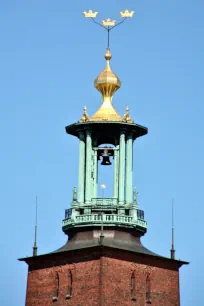
The 106-meter-tall (348 ft) bell tower of the city hall stands as a beacon on the bay. Those who make the effort to climb its 365 steps are awarded with magnificent views over Stockholm and Gamla Stan in particular. The tower is crowned with a cupola, topped by a weather vane with three crowns (tre kronor) – the national emblem of Sweden.
Inside the tower is the Tornmuseet or Tower Museum, which contains models of the many statues found in the city hall. Both the tower and museum are open in the summer. At the foot of the tower is the tomb of Birger Jarl, the legendary founder of Stockholm.
Interior
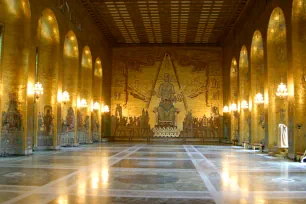
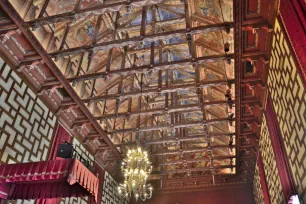
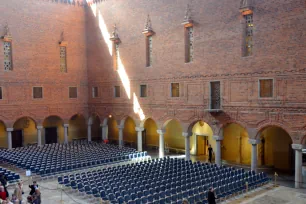
Östberg commissioned the best sculptors of his time to decorate the new city hall. This is not only visible on the exterior, which is adorned with several statues but especially inside, where mosaics and wall paintings embellish the grand halls.
The Council Hall (Rådssalen), where the city council meets, has a painted wooden ceiling inspired by Viking architecture.
The Blue Hall (Blå Hallen), with a beautiful mosaic floor and magnificent staircase, is a banquet hall, best known as the scene of the Nobel Prize festivities that take place here every year on December 10. Despite its name, the hall is not blue. The original plans called for the walls to be covered with blue glazed tiles, but Östberg was so impressed by the dark red color of the bricks, that he changed his mind.
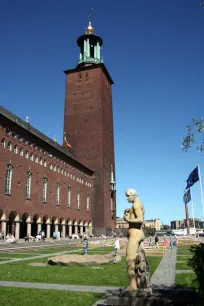
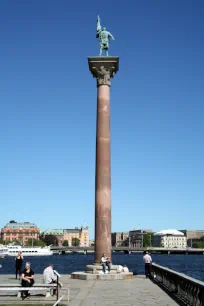
The most famous hall in the Stadshuset is the Golden Hall (Gyllene Salen). Its walls are covered with magnificent Byzantine style mosaics. The hall hasn’t stolen its name: ten kilos of gold were used by the artist Einar Forseth for the creation of the mosaics.
The Prinsens Galleri, a long hall above the Italianesque colonnade facing the lake, is decorated with a fresco painting by Prince Eugen.
Stadshusterrassen
The Stadshusterrassen, a symmetrically laid out terrace garden facing lake Mälaren, is embellished with two granite shell-shaped fountains and several sculptures. On either side of steps leading to the lake stand statues created by Carl Eldh. A female figure represents Dansen (the dance) and a male figure represents Sången (the song). Three more statues of Eldh on the terrace show important figures in Swedish culture: the writer August Strindberg, the poet Gustaf Fröding and the painter Ernst Josephson.
The fifteenth-century freedom fighter and national hero Engelbrekt Engelbrektsson is also honored with a statue, created by Christian Eriksson. Standing high on top of a column in a corner of the terrace near the lake, the statue is even visible from Riddarholmen across the Riddarfjärden bay.
- Next: Storkyrkan
- More Sights & Attractions in Stockholm

